Fabric mildew stains can be frustrating and unsightly, but with the right knowledge and techniques, you can successfully restore your textiles to their former glory.
Mildew, a form of mold, thrives in damp, humid environments and can quickly take hold of fabrics, leaving behind stains and potentially causing structural damage.
This guide will explore effective methods to remove mildew stains from various fabric types.
From gentle cleaning solutions like vinegar and lemon juice to preventive measures that help you avoid future mildew growth, we’ll cover everything you need to know to rescue your fabrics and keep them looking pristine.
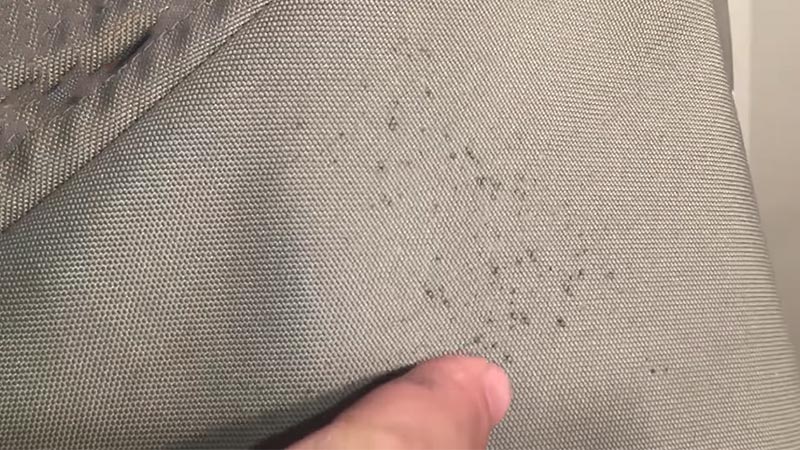
What Is Mildew Stain?
Mildew stains are discolorations or spots resulting from mold or mildew growth on surfaces. Mildew is a type of fungus that thrives in warm, damp, and humid conditions.
It appears as a thin, usually black or dark green growth on various materials like fabrics, wood, paper, and even some types of plastics.
Mildew can be particularly problematic for fabrics, as it leaves unsightly stains and can weaken the material over time.
These stains can be especially common in areas with high humidity levels or where moisture is trapped for extended periods, such as in basements, bathrooms, or poorly ventilated spaces.
How to Remove Mildew Stain From Fabric?
Mildew stains on fabric can be unsightly and sometimes difficult to remove, but with the right approach, you can restore your fabric to its former glory.
Here’s a step-by-step guide on how to remove mildew stains from fabric:
Materials You’ll Need:
- Rubber Gloves.
- White Vinegar.
- Baking Soda.
- Lemon Juice.
- Soft Brush or Sponge.
- Old Toothbrush.
- Clean Cloth or Towel.
Step-by-Step Guide:
Step 1: Safety First
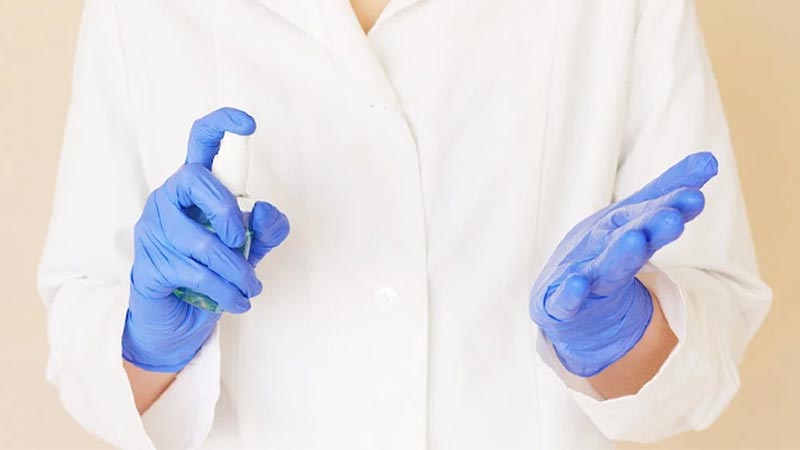
Before you start, always put on rubber gloves. This protects your hands from any chemicals you might use and ensures a hygienic cleaning process.
Additionally, consider wearing old clothes or an apron to shield your clothing from potential splashes.
Step 2: Ventilation
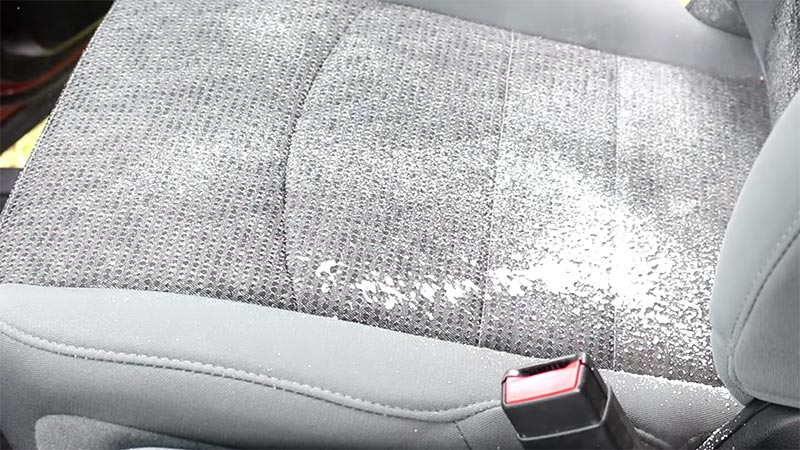
Ensure you’re working in a well-ventilated area. If possible, open windows and doors to allow fresh air to circulate.
This precaution is crucial for your comfort and safety, as it minimizes any potential inhalation of fumes from the cleaning agents.
Step 3: Test in an Inconspicuous Area
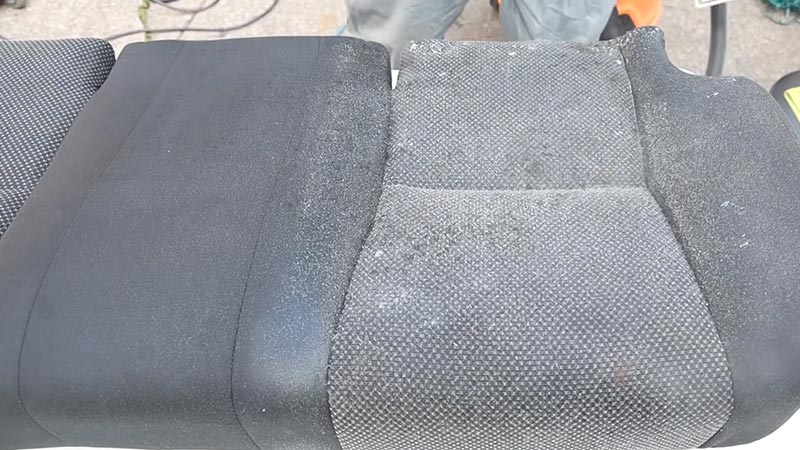
Choose a small, inconspicuous area of the fabric, such as a seam or inside fold, for a preliminary test. Apply a small amount of your chosen cleaning solution and wait a few minutes.
Carefully inspect for any adverse reactions like color fading, bleeding, or fabric damage. This test ensures that the cleaning solution won’t harm the fabric.
Step 4: Brush Off Loose Mildew
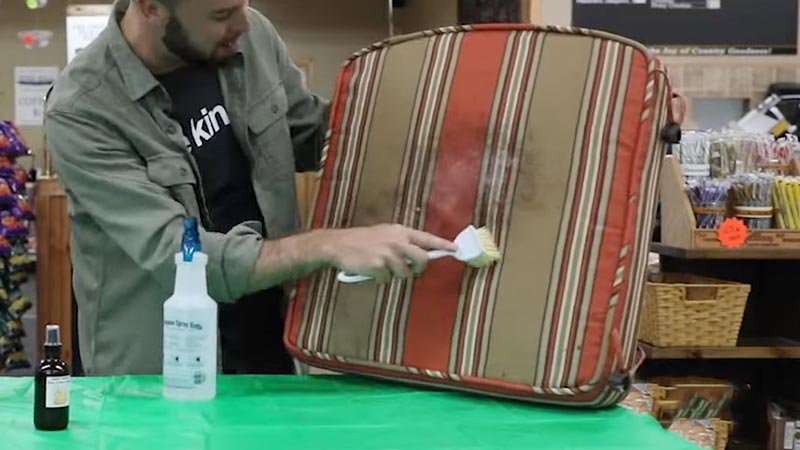
Gently remove any loose mildew from the surface using a soft brush or cloth. Pay close attention to seams and crevices, as mildew often hides in these areas. Be cautious not to scrub too vigorously, especially if dealing with delicate or older fabrics.
Step 5: Vinegar Solution
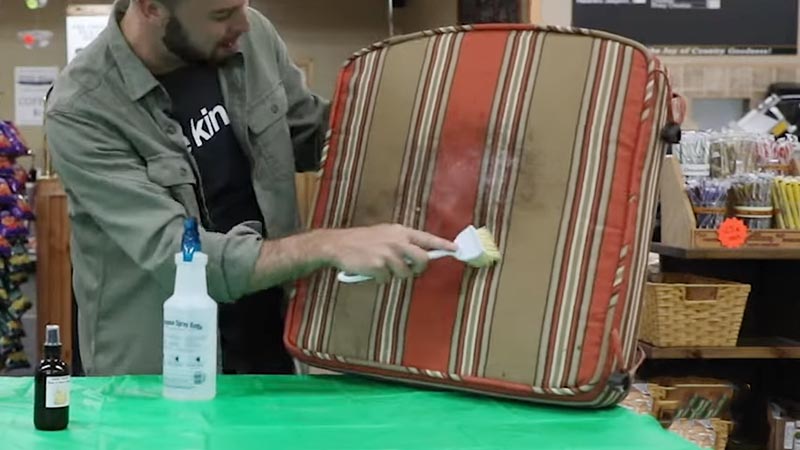
In a spray bottle, mix equal parts white vinegar and water. The acetic acid in vinegar is a natural disinfectant and works as a mild acid to break down mildew stains.
Ensure the affected area is thoroughly saturated with the solution. Allow it to sit for a few minutes to allow the vinegar to penetrate the stain.
Step 6: Blot and Scrub
Using a clean cloth, gently blot the area to lift the mildew. For tougher stains, employ a gentle scrubbing motion with a soft brush or sponge. Do not apply excessive pressure, as this could potentially harm the fabric.
Step 7: Rinse Thoroughly
After treating the stain, rinse the fabric with clean water. This step is especially important for delicate fabrics that may be sensitive to the acidity of vinegar.
Ensure all traces of the cleaning solution are thoroughly removed to prevent any potential damage.
Step 8: Baking Soda Paste
If the stain persists, create a paste using baking soda and water. This mixture acts as a gentle abrasive that can help lift stubborn stains.
Apply the paste to the affected area, using your fingers or a soft brush to rub it gently. Allow it to sit for a few minutes to work its magic.
Step 9: Sunlight and Lemon Juice
Lemon juice serves as a natural bleaching agent. Apply it to the stain, then place the fabric in direct sunlight for a few hours.
The combination of lemon juice and sunlight can be particularly effective in lightening and removing stains. Keep a close eye on the fabric to ensure it doesn’t bleach unevenly.
Step 10: Rinse and Launder
After applying lemon juice (if necessary) and letting the fabric air out, rinse it thoroughly once more to ensure no residual cleaning agents remain.
Finally, launder the fabric according to its care instructions. Double-check to ensure the stain is completely gone before proceeding to dry it.
Step 11: Check Before Drying
Before allowing the fabric to dry, inspect it under good lighting to ensure the stain is gone. Heat from a dryer can sometimes set stains, so it’s crucial to remove the stain before this final step.
What Causes Mildew to Grow On Fabric and Make It Look Dirty?
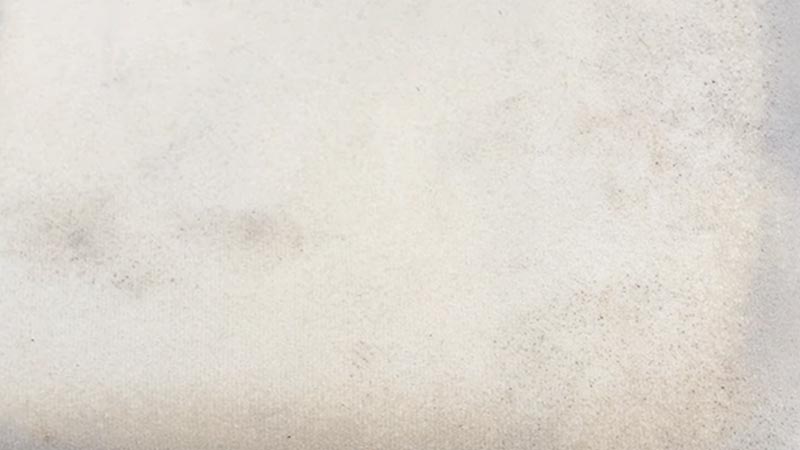
Mildew, a type of mold, thrives in environments with high humidity, warmth, and poor ventilation. When these conditions are met, it can lead to mildew growth on fabric.
Here’s a closer look at the factors that contribute to mildew growth and its impact on fabric:
High Humidity
Excess moisture in the air provides the ideal breeding ground for mildew. Fabrics that are exposed to humid conditions or stored in damp environments are more susceptible to mildew growth.
Poor Ventilation
Inadequate airflow in an area can lead to stagnant, humid conditions. This lack of ventilation prevents moisture from dissipating, creating a favorable environment for mildew to thrive.
Dark and Damp Spaces
Dark and poorly lit areas, such as closets or basements, can harbor mildew growth. These spaces often have limited sunlight exposure, inhibiting the natural disinfecting effects of UV rays.
Organic Materials
Fabrics are made of organic materials like cotton, wool, or silk. These natural fibers can provide nutrients for mildew, encouraging its growth.
Delayed Drying
When fabrics remain damp for an extended period, mildew spores can settle and begin to multiply. This commonly occurs when clothes or linens are stored without being properly dried.
Spills or Water Exposure
Accidental spills or prolonged exposure to water can introduce moisture to fabrics. If not dried promptly, this moisture can lead to mildew growth.
Improper Storage
Storing fabrics in areas prone to moisture, such as a damp basement or an attic with a leaking roof, can create conditions conducive to mildew growth.
Seasonal Changes
Changes in temperature and humidity levels, particularly during seasons with higher humidity, can contribute to mildew growth on stored fabrics.
Impact on Fabric’s Appearance
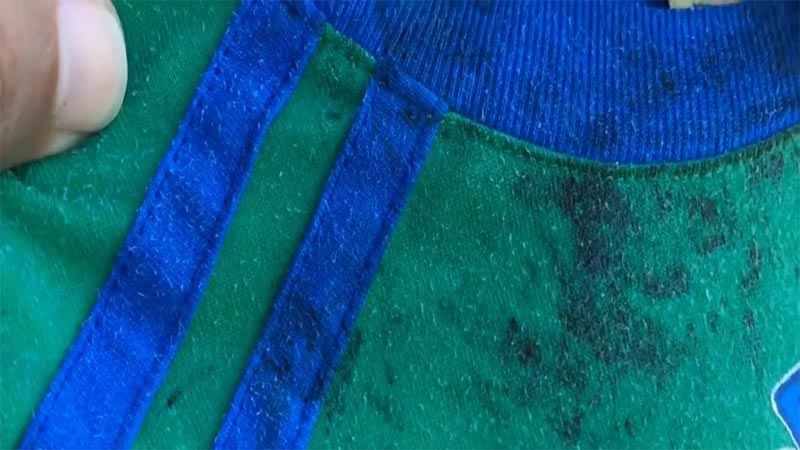
Mildew growth on fabric can have a significant negative impact on its appearance.
Here’s a closer look at how mildew can affect the visual and tactile qualities of fabric:
Stains
Mildew typically appears as dark, discolored spots or patches on the fabric’s surface. These stains are often green, gray, black, or brown and can vary in size and shape.
They are particularly noticeable on light-colored fabrics, and their presence can make the fabric look dirty and unkempt.
Musty Odor
Mildew growth is often accompanied by a musty, unpleasant odor. This odor can permeate the fabric, making it less enjoyable to use or wear.
Discoloration
Over time, mildew can cause permanent discoloration of the fabric. Even after the mildew is removed, the affected area may remain slightly discolored or faded compared to the rest of the fabric.
Texture Changes
Mildew can alter the texture of the fabric. The affected areas may feel rough or gritty to the touch due to the presence of mold and mildew spores.
Weakened Fibers
Mildew can weaken the fabric’s fibers. As it grows and spreads, mildew can break down the chemical structure of the fabric, making it more susceptible to tears, holes, and other forms of damage.
Structural Damage
When left untreated for an extended period, severe mildew infestations can lead to structural damage in the fabric. This can result in the fabric losing its integrity, becoming fragile, and developing holes or tears.
Permanent Damage
In some cases, mildew stains can be challenging to remove completely, especially if they have been allowed to set into the fabric for an extended period. This can result in permanent damage to the appearance of the fabric.
Aesthetic Displeasure
Ultimately, mildew growth detracts from the fabric’s overall aesthetic appeal. Whether it’s a piece of clothing, upholstery, or linens, the presence of mildew stains can make the fabric appear unsightly and unclean.
Preventive Measures for Mildew From Growing on the Fabric
Preventing mildew growth on fabric involves creating an inhospitable environment to mold and fungus.
Here are some effective preventive measures:
Maintain a Dry Environment
Ensure that the area where fabrics are stored or used remains consistently dry. Regularly check for any signs of moisture accumulation. Consider using a hygrometer to monitor humidity levels, especially in areas prone to dampness.
Proper Storage
Store fabrics in a location that is free from dampness or high humidity. Avoid placing them directly on the floor or against walls, as these areas are more likely to collect moisture.
Adequate Air Circulation
Arrange fabrics in a way that allows air to circulate around them. Avoid tightly stacking or cramming them into confined spaces, as this can impede air movement and create pockets of stagnant air.
Regular Cleaning
Perform routine cleaning in the environment where fabrics are stored. Dusting surfaces, vacuuming floors, and wiping down shelves are essential practices. Additionally, clean any spills or water leaks promptly to prevent dampness.
Sunlight Exposure
Utilize natural sunlight to your advantage. When possible, take fabrics outdoors to air them out in the sun. Sunlight acts as a natural disinfectant and can help deter mildew growth.
Use Moisture Absorbers
Place moisture-absorbing materials strategically near fabrics. Silica gel packs, activated charcoal, or even commercial desiccants can help reduce humidity levels and prevent moisture buildup.
Promptly Address Dampness
Act swiftly if any fabric becomes damp. Whether it’s due to spills, washing, or accidental exposure to moisture, ensure the fabric is thoroughly dried before returning it to storage.
Regular Inspections
Take the time to inspect stored fabrics periodically. Look for any signs of discoloration, musty odors, or visible mold growth. Early detection allows for immediate action to prevent further damage.
Avoid Storing Wet Items
Be cautious not to store wet or damp items alongside dry fabrics. This practice can introduce excess moisture into the storage environment, creating favorable conditions for mildew growth.
Select Mildew-Resistant Fabrics
When possible, opt for fabrics that have inherent resistance to mildew. Certain synthetic materials or fabrics treated with mildew-resistant coatings are less susceptible to fungal growth.
Ensure Proper Ventilation
Ensure that the spaces where fabrics are stored are well-ventilated. Use fans or consider installing vents to promote air circulation and reduce humidity levels.
Follow Fabric Care Instructions
Always adhere to the care instructions provided by the fabric manufacturer. These instructions may include specific recommendations for preventing mildew, such as avoiding prolonged moisture exposure or using certain cleaning agents.
FAQs
What is the best way to remove mildew stains from fabric?
The most effective method is to create a mixture of equal parts white vinegar and water. Spray the affected area, blot, and then rinse thoroughly.
Can I use bleach to remove mildew stains from the fabric?
While bleach can be effective, it’s important to use it cautiously as it may weaken or discolor certain fabrics. Always test in an inconspicuous area first.
How do I prevent mildew stains from returning after cleaning?
Ensure the fabric is completely dry before storing. Store in a well-ventilated area, and regularly inspect and clean the storage space.
Can I use lemon juice to remove mildew stains?
Yes, lemon juice can be effective due to its natural bleaching properties. Apply lemon juice to the stain and let it sit in the sunlight.
Are there any specific fabrics that are more prone to mildew stains?
Natural fibers like cotton, wool, and silk are more susceptible to mildew. Fabrics stored in damp, humid conditions are also at higher risk.
Wrap Up
Effectively removing mildew stains from fabric requires a combination of diligence and the right cleaning techniques. Prompt action is crucial, as mildew can weaken fibers and leave unsightly marks.
Using a mixture of white vinegar and water, along with natural remedies like lemon juice and sunlight, proves effective.
It’s essential to test any cleaning solution in an inconspicuous area and follow fabric care instructions diligently.
Prevention is equally important; maintaining a dry environment, proper storage, and regular inspections can prevent mildew growth.
By following these steps, fabrics can be restored to their original condition, prolonging their lifespan and maintaining their aesthetic appeal.
Leave a Reply